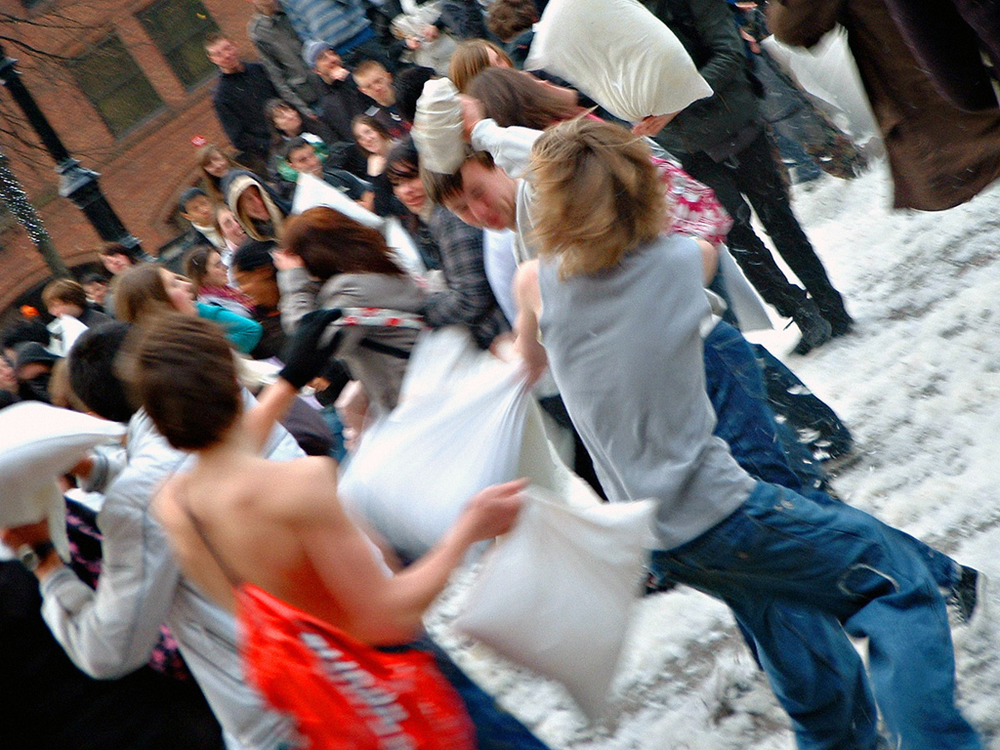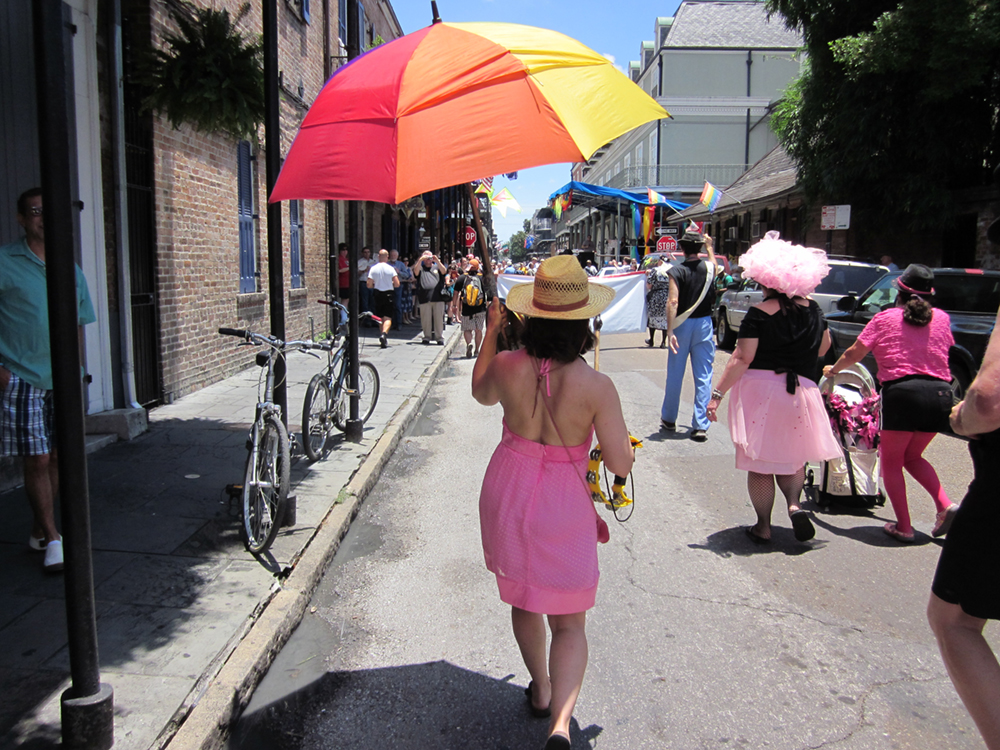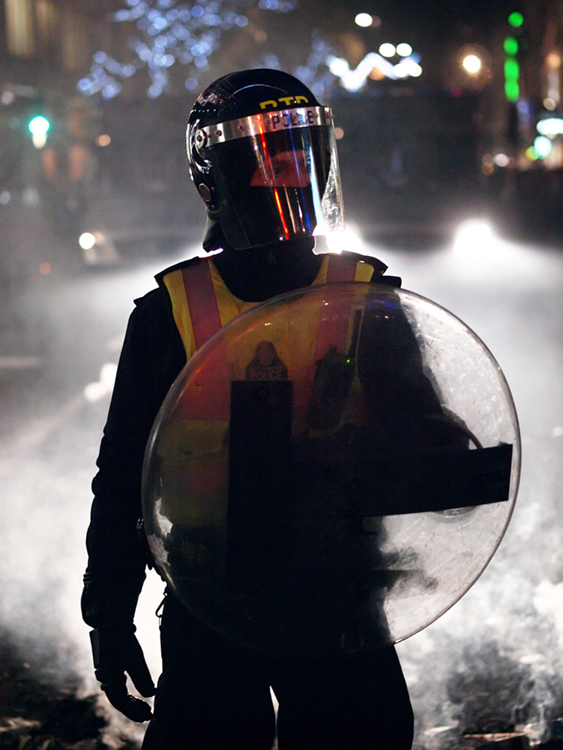Collective Behavior
- Describe different forms of collective behavior
- Differentiate between types of crowds
- Discuss emergent norm, value-added, and assembling perspective analyses of collective behavior
Flash Mobs

People sitting in a café in a touristy corner of Rome might expect the usual sights and sounds of a busy city. They might be more surprised when, as they sip their espressos, hundreds of young people start streaming into the picturesque square clutching pillows, and when someone gives a signal, they start pummeling each other in a massive free-for-all pillow fight. Spectators might lean forward, coffee forgotten, as feathers fly and more and more people join in. All around the square, others hang out of their windows or stop on the street, transfixed, to watch. After several minutes, the spectacle is over. With cheers and the occasional high five, the crowd disperses, leaving only destroyed pillows and clouds of fluff in its wake.
This is a flash mob, a large group of people who gather together in a spontaneous activity that lasts a limited amount of time before returning to their regular routines. Technology plays a big role in the creation of a flash mob: select people are texted or emailed, and the message spreads virally until a crowd has grown. But while technology might explain the “how” of flash mobs, it does not explain the “why.” Flash mobs often are captured on video and shared on the internet; frequently they go viral and become well-known. So what leads people to want to flock somewhere for a massive pillow fight? Or for a choreographed dance? Or to freeze in place? Why is this appealing? In large part, it is as simple as the reason humans have bonded together around fires for storytelling, or danced together, or joined a community holiday celebration. Humans seek connections and shared experiences. And a flash mob, pillows included, provides a way to make that happen.
Flash mobs are examples of collective behavior, non-institutionalized activity in which several people voluntarily engage. Other examples of collective behavior can include anything from a group of commuters traveling home from work to the trend toward adopting the Justin Bieber hair flip. In short, it can be any group behavior that is not mandated or regulated by an institution. There are four primary forms of collective behavior: the crowd, the mass, the public, and social movements.
It takes a fairly large number of people in close proximity to form a crowd (Lofland 1993). Examples include a group of people attending an Ani DiFranco concert, tailgating at a Patriots game, or attending a worship service. Turner and Killian (1993) identified four types of crowds. Casual crowds** consist of people who are in the same place at the same time, but who aren’t really interacting, such as people standing in line at the post office. **Conventional crowds are those who come together for a scheduled event occurring regularly, like a religious service. Expressive crowds are people who join together to express emotion, often at funerals, weddings, or the like. The final type, acting crowds, focus on a specific goal or action, such as a protest movement or riot.
In addition to the different types of crowds, collective groups can also be identified in two other ways. A mass is a relatively large number of people with a common interest, though they may not be in close proximity (Lofland 1993), such as players of the popular Facebook game Farmville. A public, on the other hand, is an unorganized, relatively diffused group of people who share ideas, such as the Libertarian political party. While these two types of crowds are similar, they are not the same. To distinguish between them, remember that members of a mass share interests whereas members of a public share ideas.
Theoretical Perspectives on Collective Behavior
Early collective behavior theories (LeBon 1895; Blumer 1969) focused on the irrationality of crowds. Eventually, those theorists who viewed crowds as uncontrolled groups of irrational people were supplanted by theorists who viewed the behavior some crowds engaged in as the rational behavior of logical beings.
Emergent-Norm Perspective

Sociologists Ralph Turner and Lewis Killian (1993) built on earlier sociological ideas and developed what is known as emergent norm theory. They believe that the norms experienced by people in a crowd may be disparate and fluctuating. They emphasize the importance of these norms in shaping crowd behavior, especially those norms that shift quickly in response to changing external factors. Emergent norm theory **asserts that, in this circumstance, people perceive and respond to the crowd situation with their particular (individual) set of norms, which may change as the crowd experience evolves. This focus on the individual component of interaction reflects a symbolic interactionist perspective.
For Turner and Killian, the process begins when individuals suddenly find themselves in a new situation, or when an existing situation suddenly becomes strange or unfamiliar. For example, think about human behavior during Hurricane Katrina. New Orleans was decimated and people were trapped without supplies or a way to evacuate. In these extraordinary circumstances, what outsiders saw as “looting” was defined by those involved as seeking needed supplies for survival. Normally, individuals would not wade into a corner gas station and take canned goods without paying, but given that they were suddenly in a greatly changed situation, they established a norm that they felt was reasonable.
Once individuals find themselves in a situation ungoverned by previously established norms, they interact in small groups to develop new guidelines on how to behave. According to the emergent-norm perspective, crowds are not viewed as irrational, impulsive, uncontrolled groups. Instead, norms develop and are accepted as they fit the situation. While this theory offers insight into why norms develop, it leaves undefined the nature of norms, how they come to be accepted by the crowd, and how they spread through the crowd.
Value-Added Theory
Neil Smelser’s (1962) meticulous categorization of crowd behavior, called value-added theory, is a perspective within the functionalist tradition based on the idea that several conditions must be in place for collective behavior to occur. Each condition adds to the likelihood that collective behavior will occur. The first condition is structural conduciveness, which describes when people are aware of the problem and have the opportunity to gather, ideally in an open area. Structural strain, the second condition, refers to people’s expectations about the situation at hand being unmet, causing tension and strain. The next condition is the growth and spread of a generalized belief, wherein a problem is clearly identified and attributed to a person or group.
Fourth, precipitating factors spur collective behavior; this is the emergence of a dramatic event. The fifth condition is mobilization for action, when leaders emerge to direct a crowd to action. The final condition relates to action by the agents. Called social control, it**is the only way to end the collective behavior episode (Smelser 1962).
Let’s consider a hypothetical example of these conditions. In structure conduciveness (awareness and opportunity), a group of students gathers on the campus quad. Structural strain emerges when they feel stress concerning their high tuition costs. If the crowd decides that the latest tuition hike is the fault of the Chancellor, and that she’ll lower tuition if they protest, then growth and spread of a generalized belief has occurred. A precipitation factor arises when campus security appears to disperse the crowd, using pepper spray to do so. When the student body president sits down and passively resists attempts to stop the protest, this represents mobilization of action. Finally, when local police arrive and direct students back to their dorms, we’ve seen agents of social control in action.
While value-added theory addresses the complexity of collective behavior, it also assumes that such behavior is inherently negative or disruptive. In contrast, collective behavior can be non-disruptive, such as when people flood to a place where a leader or public figure has died to express condolences or leave tokens of remembrance.

Assembling Perspective
Interactionist sociologist Clark McPhail (1991) developed assembling perspective, another system for understanding collective behavior that credited individuals in crowds as rational beings. Unlike previous theories, this theory refocuses attention from collective behavior to collective action. Remember that collective behavior is a non-institutionalized gathering, whereas collective action is based on a shared interest. McPhail’s theory focused primarily on the processes associated with crowd behavior, plus the lifecycle of gatherings. He identified several instances of convergent or collective behavior, as shown on the chart below.
Clark McPhail identified various circumstances of convergent and collective behavior (McPhail 1991).
|
Type of crowd
|
Description
|
Example
|
| Convergence clusters |
Family and friends who travel together |
Carpooling parents take several children to the movies |
| Convergent orientation |
Group all facing the same direction |
A semi-circle around a stage |
| Collective vocalization |
Sounds or noises made collectively |
Screams on a roller coaster |
| Collective verbalization |
Collective and simultaneous participation in a speech or song |
Pledge of Allegiance in the school classroom |
| Collective gesticulation |
Body parts forming symbols |
The YMCA dance |
| Collective manipulation |
Objects collectively moved around |
Holding signs at a protest rally |
| Collective locomotion |
The direction and rate of movement to the event |
Children running to an ice cream truck |
As useful as this is for understanding the components of how crowds come together, many sociologists criticize its lack of attention on the large cultural context of the described behaviors, instead focusing on individual actions.
Summary
Collective behavior is non-institutionalized activity in which several people voluntarily engage. There are four different forms of collective behavior: crowd, mass, public, and social movement. There are three main theories on collective behavior. The first, the emergent-norm perspective, emphasizes the importance of social norms in crowd behavior. The next, the value-added theory, is a functionalist perspective that states that several preconditions must be in place for collective behavior to occur. Finally the assembling perspective focuses on collective action rather than collective behavior, addressing the processes associated with crowd behavior and the lifecycle and various categories of gatherings.
Section Quiz
Which of the following organizations is not an example of a social movement?
- National Football League
- Tea Party
- Greenpeace
- NAACP
Sociologists using conflict perspective might study what?
- How social movements develop
- What social purposes a movement serves
- What motivates inequitably treated people to join a movement
- What individuals hope to gain from taking part in a social movement
Which of the following is an example of collective behavior?
- A soldier questioning orders
- A group of people interested in hearing an author speak
- A class going on a field trip
- Going shopping with a friend
The protesters at the Egypt uprising rally were:
- a casual crowd
- a conventional crowd
- a mass
- an acting crowd
According to emergent-norm theory, crowds are:
- irrational and impulsive
- often misinterpreted and misdirected
- able to develop their own definition of the situation
- prone to criminal behavior
A boy throwing rocks during a demonstration might be an example of ___________.
- structural conduciveness
- structural strain
- precipitating factors
- mobilization for action
Short Answer
Discuss the differences between a mass and a crowd. What is an example of each? What sets them apart? What do they share in common?
Can you think of a time when your behavior in a crowd was dictated by the circumstances? Give an example of emergent-norm perspective, using your own experience.
Discuss the differences between an acting crowd and a collective crowd. Give examples of each.
Imagine you are at a rally protesting nuclear energy use. Walk us through the hypothetical rally using the value-added theory, imagining it meets all the stages.
References
Blumer, Herbert. 1969. “Collective Behavior.” Pp. 67–121 in Principles of Sociology, edited by A.M. Lee. New York: Barnes and Noble.
LeBon, Gustave. 1960 [1895]. The Crowd: A Study of the Popular Mind. New York: Viking Press.
Lofland, John. 1993. “Collective Behavior: The Elementary Forms.” Pp. 70–75 in Collective Behavior and Social Movements, edited by Russel Curtis and Benigno Aguirre. Boston: Allyn and Bacon.
McPhail, Clark. 1991. The Myth of the Madding Crowd. New York: Aldine de Gruyter.
Smelser, Neil J. 1963. Theory of Collective Behavior. New York: Free Press.
Turner, Ralph and Lewis M. Killian. 1993. Collective Behavior. 4th ed. Englewood Cliffs, N. J., Prentice Hall.
Glossary
- acting crowds
- crowds of people who**are focused on a specific action or goal
- assembling perspective
- a theory that credits individuals in crowds as behaving as rational thinkers and views crowds as engaging in purposeful behavior and collective action
- casual crowds
- people who share close proximity without really interacting
- collective behavior
- a non-institutionalized activity in which several people voluntarily engage
- conventional crowds
- people who come together for a regularly scheduled event
- crowd
- when a fairly large number of people share close proximity
- emergent norm theory
- a perspective that emphasizes the importance of social norms in crowd behavior
- expressive crowds
- crowds who share opportunities to express emotions
- flash mob
- a large group of people who gather together in a spontaneous activity that lasts a limited amount of time
- mass
- a relatively large group with a common interest, even if they may not be in close proximity
- public
- an unorganized, relatively diffuse group of people who share ideas
- value-added theory
- a functionalist perspective theory that posits that several preconditions must be in place for collective behavior to occur

This work is licensed under a Creative Commons Attribution 4.0 International License.
You can also download for free at http://cnx.org/contents/02040312-72c8-441e-a685-20e9333f3e1d@10.1
Attribution:



